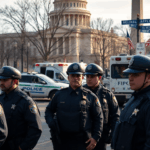Table of Contents
Air traffic chaos: Newark airport’s communication breakdown explained
In a shocking turn of events, Newark Liberty International Airport faced a significant communication breakdown that left air traffic controllers scrambling and pilots in distress. This incident, which occurred on April 28, has raised serious concerns about the reliability of air traffic control systems in one of the busiest airports in the United States.
The audio recordings from the event reveal the tense moments when pilots lost contact with controllers, highlighting the fragility of our aviation infrastructure.
The moment of silence
Imagine being a pilot, approaching Newark after a long flight from New Orleans, only to find yourself in a communication black hole.
That’s exactly what happened when the United Airlines pilot attempted to reach out to air traffic control multiple times, only to be met with silence. “Approach, are you there?” he asked, a question that echoed the anxiety felt by many in the cockpit.
After what felt like an eternity, the controller finally responded, “United 1951, how do you hear me?” This exchange underscores the critical nature of communication in aviation, where every second counts.
What caused the breakdown?
Transportation Secretary Sean Duffy confirmed that the primary communication line had failed, and the backup system did not activate, leading to a 30-second loss of contact.
While this may seem brief, in the world of aviation, it can lead to chaos. Duffy reassured the public that there was no immediate danger of crashes, as planes are equipped with multiple communication devices. However, he acknowledged that this incident is indicative of a larger issue: a frail system that requires urgent attention and repair.
The aftermath: Delays and cancellations
The fallout from this communication failure was immediate and severe. Thousands of flights were delayed or canceled, leaving travelers stranded and frustrated. The Federal Aviation Administration (FAA) attributed the chaos to a shortage of air traffic controllers at Newark, compounded by ongoing runway construction.
United Airlines CEO Scott Kirby pointed out that 20% of Newark’s controllers had recently walked off the job, exacerbating the situation. However, the controllers’ union clarified that these absences were due to stress-related issues, not a mass walkout.
Looking ahead: The need for reform
This incident serves as a wake-up call for the aviation industry. With increasing air traffic and a growing number of flights, the need for a robust air traffic control system has never been more critical. The FAA and airport authorities must prioritize staffing and infrastructure improvements to prevent future breakdowns. As travelers, we deserve a system that ensures our safety and efficiency in the skies. The recent chaos at Newark is a reminder that while technology has advanced, our systems must evolve to meet the demands of modern air travel.





